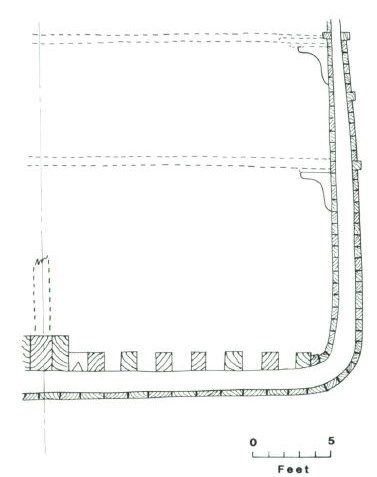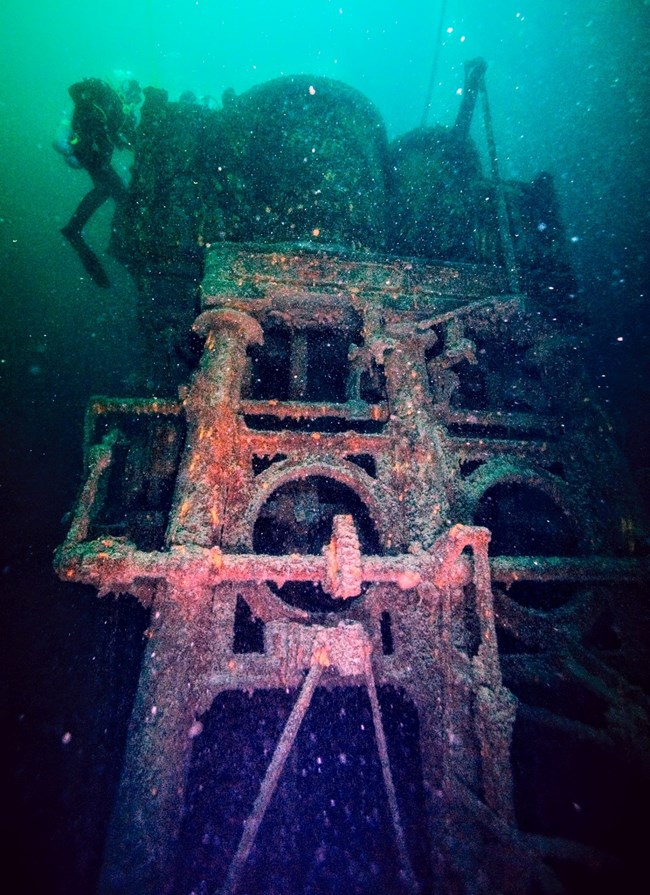Last updated: September 24, 2020
Article
SS Henry Chisholm: Wreck Event

NPS / Submerged Cultural Resources Unit
Wreck Event
The last voyage of Henry Chisholm began in Duluth on Sunday, October 16, 1898. Chisholm was loaded with 92,000 bushels of barley. The ship was downbound for Buffalo with the 220-foot schooner John Martin in tow, carrying 1.2 million board feet of lumber. Captain P.H. Smith was master of Henry Chisholm and the captain of John Martin was James Lawless, second master of Chisholm. Both vessels were majority owned by M.A. Bradley of Cleveland (Wisconsin State Journal, Oct. 21, 1898).
A gale arose and the weather was heavy by the time the two vessels neared Copper Harbor on the Keweenaw Point. Martin, with fore and main sails set, cast off the tow line about 5:30 p.m. Monday (Oct. 17) and was soon lost to view. There was a heavy southeast wind and Chisholm's captain headed up the Lake across the wind (Ft. William Daily Journal, Oct. 21, 1898). Chisholm cruised about until Tuesday morning in an effort to locate the missing schooner (Superior Evening Telegram, Oct. 21, 1898).
Chisholm headed for the Apostle Island group and refueled at Ashland. The search for John Martin was resumed at 11:00 a.m. Tuesday. The search route ran to the north shore with a call at Grand Marais, and from there to search the Isle Royale area (Ft. William Daily Journal Oct. 21, 1898).
The wreck occurred on Thursday, October 20 at either 5:00 a.m. (The Daily Journal, Oct. 21, 1898) or at 8:00 a.m. while the ship was trying to enter Washington Harbor (Wisconsin State Journal, Oct. 21, 1898). Chisholm was doing about 9 knots, full speed, when it struck the Rock of Ages reef. The ship carried a crew of 16 (Duluth Evening Herald, Oct. 21, 1898).
Soon after striking the reef, Capt. Smith and First Mate Whitsman (or Whitman), who had been consulting in the ship's cabin, rushed to the deck and saw many fragments of heavy oak hull planking floating in the water. The captain decided there was no hope of pulling it off and launched the 18-foot lifeboat or yawl boat (Detroit Free Press, Oct. 22, 1898) under the command of the first mate. Along with Whitsman in the lifeboat were Second Mate Gilbert Wide (Wilde), Wheelsmen James Agger and Angus MacDonald, and Seaman Harry G. Carrow. These men set out rowing for Victoria Harbor 14.5 miles away. They arrived there about 11:00 a.m. and were picked up by the steamer Dixon (Ft. William Daily Journal, Oct. 21, 1898).

NPS
Dixon (probably Hiram R. Dixon, a 329 gross-ton propeller built in 1883 at Mystic, Connecticut) arrived in Duluth with the shipwrecked crew aboard (Wisconsin State Journal, Oct. 21, 1898). This same account said the crew had gone to Isle Royale before Whitsman was dispatched to report the vessel's loss. Chisholm was reported rapidly breaking up and feared a total loss. A wrecking expedition sent by the Inman Tug Line had been dispatched.
Soon after the lifeboat under command of the first mate left Chisholm, the captain and remainder of the crew rowed the 4 miles to Washington Harbor. The vessel was reported in 12 feet of water at the bow and 40 feet at the stern, listing 4 feet (Ft. William Daily Journal, Oct. 21, 1898).
John Martin, although feared water logged and lost (lumber had been spotted on the south shore), survived the ordeal in good shape. The steamer Neshoto, a 2,255 gross ton propeller commissioned that year and built at Chisholm's home port of Cleveland, arrived in Duluth on October 21 with a reported sighting of the missing John Martin off Eagle Harbor. Martin was sailing east. Martin was reported at Sault Ste. Marie the evening of the 21st under tow of the Canada-Atlantic liner Roman. Roman was a 2,348 gross ton package freighter built in 1891 in Cleveland. It was reported Roman picked up Martin off Copper Harbor, near where it was originally separated from Henry Chisholm (Detroit Free Press, Oct. 22, 1898; Duluth Evening Herald, Oct. 22, 1898).
